India’s Most Rural State Sees Rising Incomes
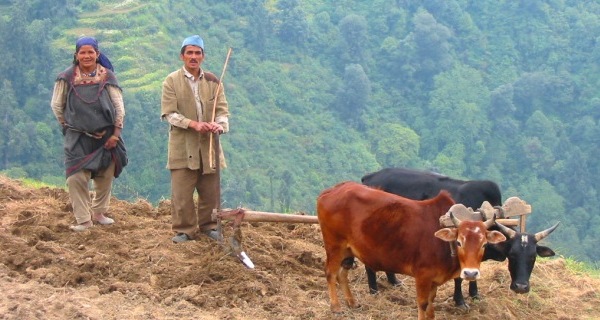
| Highlights* Himachal Pradesh is the only state in India with nearly 90% of the population living in rural areas * Boosting agriculture crucial for economic growth of the state * Per capita income has been rising steadily in Himachal Pradesh |
India’s hill state of Himachal Pradesh went to the polls in the first week of November. IndiaSpend’s Dhritiman Gupta looks at the state’s balance sheet to see the factors that could determine the political course of the state’s future.
According to the 2011 Census, Himachal Pradesh is the only state in India with nearly 90% of the population living in rural areas. So, agriculture plays an important role in its economy.The Figure 1 below shows the All India and Himachal Pradesh growth rates from 2007-08 to 2011-12
Figure 1
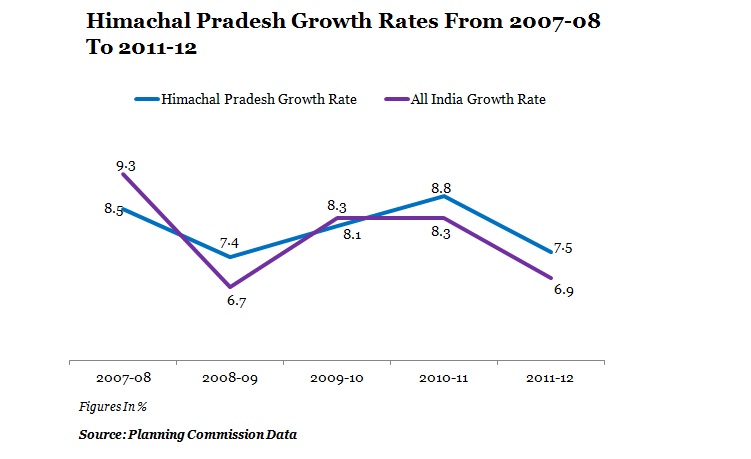
The table below gives a few more detailed numbers
Table 1: Growth Rate of GSDP and Per Capita Income
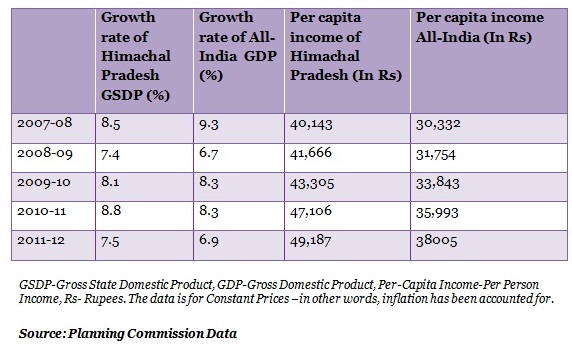
Over 2007-12, Himachal Pradesh has grown consistently at rates higher than 7% (Table 1). Growth slipped in 2008-09 and 2011-12 due to global worries but the hit for the Himachal economy was much lower than the whole of India.
While the all-India growth rate slipped from 9.3% in 2007-08 to 6.7 % in 2008-09, it fell only from 8.5% to 7.4% in Himachal Pradesh. Similarly, growth rates slipped from 8.3% in 2010-11 to 6.9% in 2011-12 for India while the figures were 8.8% and 7.5%, respectively, for Himachal Pradesh.
On the other hand, HP’s per capita income has increased consistently from Rs 40,143 in 2007-08 to Rs 49, 187 in 2011-12. The corresponding figures for all-India are Rs 30,332 and Rs 38,005, respectively.
Thus, an average person in Himachal Pradesh earned Rs 11, 000 more than an average Indian in 2011-12. Himachal Pradesh, with a per capita income of Rs 47, 106 in 2010-11, was at the 12th spot out of 32 states and Union Territories.
The Agrarian Economy
Let us now look at the sectoral break-up of the Himachal economy. In 2010-11, the primary sector, which includes agriculture and animal husbandry, forestry and logging, fishing and mining and quarrying, contributed 21.7% to the GSDP of Himachal Pradesh.
The secondary sector, which includes manufacturing, construction, electricity, gas and water supply, contributed 39.8%. The tertiary sector that includes transport, communication, trade, finance and real estate and community and personal services contributed the remaining 38.5%.
Let’s take a closer look at the sectoral growth rates:
Table 2: Growth Rates Across Sectors
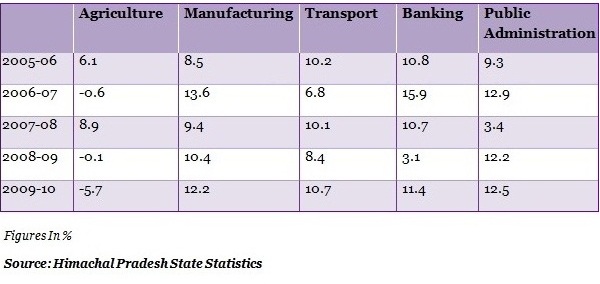
As can be seen from (Table 2), growth in the primary sector was fluctuating in the period 2005-10. The sector recorded negative growth rates in the years 2006-07, 2008-09, and 2009-10.
The secondary sector has recorded growth rates of above 8% over the whole period. The best growth rate, recorded in the year 2006-07, touched 13.6%.
The tertiary sector also recorded good growth rates. The sector recorded growth rates of above 10% in all the years except 2008-09 when growth slipped to 3.1% on account of the global recession.
Public administration, defence and services also recorded healthy growth rates in all years except 2007-08 when the growth rate was 3.1%. To sum up, all sectors, except primary, have been progressing well.
However, the primary sector, especially agriculture, plays a very important role in the economy of Himachal Pradesh given that it employs more than 70% of the working population of the state.
Curbing fluctuations in the sector is thus essential for the well-being of the majority people in the state.
Let’s now take a closer look at the growth rates in the agricultural sector:
Figure 2
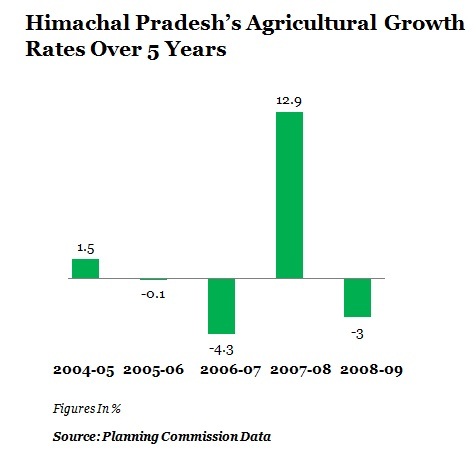
So, it is apparent from (Figure 2) that there are wide fluctuations in growth rates in the agricultural sector. Over the period 2004-09, agricultural sector recorded negative growth in 3 years. Another bad news is that average growth slowed down from 4.7% over 1996-04 to 1.3% over 2004-09.
According to Planning Commission data, about 81.5% of the cultivated area of Himachal Pradesh is rain-fed. So, fluctuations in monsoons cause serious problems in the state.
While the net sown area in Himachal Pradesh is about 5.8 lakh hectares, the irrigation potential of the state is 3.3 lakh hectares. Till December 2011, the area covered under irrigation was 2.4 lakh hectares or 72%. So, meeting the target of 100% irrigation coverage i.e. 3.3 lakh hectare would be one of the most important tasks of the next government.
It’s clear that economic growth as demonstrated through data can lead to improvements in social conditions. The dependence on agriculture is however worrying and reflects a larger trend across several states in the country.


